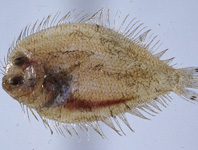Abstract
The genus Lampris (Lampridae) currently comprises two species, Lampris guttatus (Brünnich 1788) and L. immaculatus (Gilchrist 1905) commonly known as Opah and Southern Opah, respectively. Hyde et al. (2014) presented DNA sequence data which revealed the presence of five distinct, monophyletic lineages within L. guttatus. In this paper, we present morphological and meristic data supporting the presence of five species previously subsumed within L. guttatus (Brünnich 1788). We restrict Lampris guttatus (Brünnich 1788), resurrect L. lauta (Lowe 1838), and describe three new species of Lampris. A key to the species of Lampris is provided.
References
Brill, R. & Lutcavage, M. (2001) Understanding environmental influences on movements and depth distribution of tunas and billfishes can significantly improve population assessments. American Fisheries Society Symposium, 25, 179–198.
Brill, R., Bigelow, K., Musyl, M., Fritsches, K. & Warrant, J. (2005) Bigeye Tuna (Thunnus obesus) Behavior and Physiology, and their Relevance to Stock Assessments and Fishery Biology. International Commission for the Conservation of Atlantic Tunas, Collected Volume of Scientific Papers, 57, 142–161.
Choy, C., Portner, E., Iwane, M. & Drazen, J.C. (2013) Diets of five important predatory mesopelagic fishes of the central North Pacific. Marine Ecology Progress Series, 492, 169–184.
https://doi.org/10.3354/meps10518Eschmeyer, W., Fricke, R. & van der Laan (2018) Catalog of Fishes: Genera, Species, References. Available from: http://researcharchive.calacademy.org/research/ichthyology/catalog/fishcatmain.asp (accessed 15 Feb 2018)
Hawn, D. & Collette, B. (2012) What are the maximum size and live body coloration of opah (Teleostei: Lampridae: Lampris species)? Ichthyological Research, 59 (3), 272–275.
https://doi.org/10.1007/s10228-012-0277-zHubbs, C. & Lagler, K. (1964) Fishes of the Great Lakes Region with a new preface. (Reprint of the 1958 edition). University of Michigan Press, Ann Arbor, Michigan, 213 pp.
Hyde, J., Underkoffler, K. & Sundberg, M. (2014) DNA barcoding provides support for a cryptic species complex within the globally distributed and fishery important opah (Lampris guttatus). Molecular Ecology Resources, 14, 1239–1247.
https://doi.org/10.1111/1755-0998.12268Jackson, G., Buxton, N. & George, M.J. (2000) Diet of the Opah Lampris immaculatus on the Patagonia Shelf; the significance of the squid Moroteuthis ingens and anthropogenic plastic. Marine Ecology Progress Series, 206, 261–271.
https://doi.org/10.3354/meps206261Müller, O. 1806. Zoologia Danica, seu animalium Daniae et Norvegieae rariorum ac minus notorum descriptiones et Hisotria, Havniae, Vol. 4, 44 pp.
Parin, N. & Kukuyev, N. (1983) Reestablishment of the Validity of Lampris immaculatus Gilchrist 1905, and the Geographical Distribution of Lampridae. Journal of Ichthyology, 23, 1–12.
Polovina J., Hawn, D. & Abecassis, M. (2008) Vertical Movement and Habitat of Opah (Lampris guttatus) in the Central North Pacific Recorded with Pop-up Archival Tags. Marine Biology, 153(3), 257–267.
https://doi.org/10.1007/s00227-007-0801-2Sabaj M. (2016) Standard symbolic codes for institutional resource collections in herpetology and ichthyology: An Online Reference. Version 6.5. Available from: http://www.asih.org (accessed 10 July 2017)
Wegner, N., Snodgrass, O., Dewar, H. & Hyde, J. (2015) Whole-body endothermy in a mesopelagic fish, the opah, Lampris guttatus. Science, 348,786–789.
https://doi.org/10.1126/science.aaa8902

